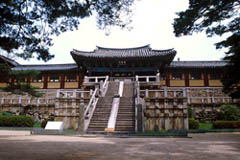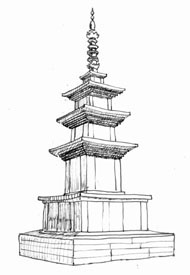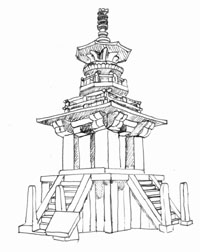|
Intro
History
Vernacular
Architecture
High-Style Architecture
Bibliography
Links |
|
This temple is one of the few remaining pieces of Silla
architecture. According
to historical records, it was founded in 535 C.E., and built by King
Pob-Hung so his queen would have a place to worship.
The architect was the legendary
Kim Tae-Song. According to folk stories, he was later reincarnated as the Prime Minister Kim
Mun-Yang. Kim Mun-Yang
personally designed the building as a tribute to his parents.
It was later repaired by King Munmu from about 661-680.
|
|
Pul-guk-sa
Temple is located eight miles east of Kyongju in the foothills of
Mt. Tohamsen. The
temple is organized in such a manner that it represents the
procession through the worlds of Buddhism:
as people enter the grounds, they mount the Sokkye-mun, a
staircase that ends at the Chaha-mun gate. The Sokkye-mun’s
thirty-one stairs are broken into two portions: the first is called
Ch’ongun-kyo (Blue Cloud Bridge), and the second is Paegun-kyo
(White Cloud Bridge).
Mounting
the stairs is a symbolic representation of entering the realm of
Buddha from the normal world.
|

The twin staircases, or
"bridges,"
of Pul-guk-sa Temple
|
|
Beyond
the Chaha-mun gate is a large courtyard with a singular focus
towards the main hall of the temple:
Taeung-jon Hall. Bordering this axis are the two entrance pagodas found in
Buddhist temples: the
Sakyamuni Pagoda and the Tabo-t’ap.
The contrast of the two pagodas, one simple, the other
complex, symbolizes creation for the Buddhists.
|
|

|
Also
known as “The Pagoda That Casts No Shadow,” Sokka-t'ap (or the
Sakyamuni Pagoda) is the western pagoda in front of
Pul-guk-sa Temple.
This
27’ tall, three-story pagoda shows many of the details that are
present in mid-Silla Pagodas: a
double-tiered pedestal, five-stepped Patchiim (supporting
stones), eaves that flare slightly, and use of single blocks of
stone to create the Ok-ssin-sŏk (main stone) and Patchiim.
The simplicity of this pagoda represents the Buddha absorbed
in transcendant calm.
|
|
Located on the east side of the path,
Tabo-t'ap
is a thirty-four foot tall pagoda that is also known as the
"pagoda of many treasures." This complicated stone
pagoda has a form that is utterly unique to Korea.
The
first story of this pagoda is a platform with four stone staircases
leading to a sheltered area created by the heavy pillars that hold
up the second story. This
enclosed area may once have held a Buddhist statue.
The second, central stage is made up of a simple cornice of
rounded, beamlike blocks of granite. |

|
Above are three eight-sided tiers, each supported by a paling
(small stones between the main tiers) of stone spokes.
The second paling is realistically carved to resemble bamboo.
Crowning this stage is a circular cornice of egg-and-dart
moldings. Atop the
top-story’s palings is a single stone that makes up the
morning-glory-shaped roof. From the center of the roof rises a finial in a
crown-ball-and-plate sequence.
The
complexity of the Tabo-t’ap represents the manifestation of Buddha
in the diverse universe.
Both
of the Pagodas of Pul-guk-sa were designed by the master craftsman
Asa-Dal, who had come from Paekche to craft them. The first to
be built was Tabo-t'ap, which took so long to build that his wife,
Asa-nyo, came to the temple to meet him. When she arrived, she wasn't
allowed to enter on account of being "unclean": the
Buddhists of that time forbade the entry of all women to their
temples. The gatekeeper eventually told Asa-nyo to go to
a neaby pond called Shadow Pond, in which she could see Tabo-t'ap
being worked on by her husband. After
making the journey, Asa-nyo looked into the pond only to see
Tabo-t'ap completed and no one about. Unbeknownst to her and
the gatekeeper, that particular pagoda had been finished, and
Asa-dal and his workers had begun work on Sokka-t'ap. In
grief, Asa-nyo threw herself into the water and cried out her
husband's name. Because
of Asa-dal's loss, Sokka-t'ap is called "the Pagoda without a
Shadow" and Tabo-t'ap is called "the Pagoda with a
Shadow."
|

 
|



|